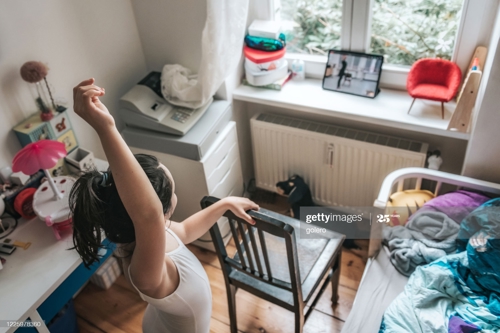Information sharing in a digital world
Author: Claire Farmer, MSc, Lecturer in Dance Science, Strength and Conditioning Coach, on behalf of the Dance Educators' Committee
Over the past few years, we have seen a steady increase in the use of technology within the arts, as dance artists explore the ways in which digital content can be utilized in the creation, documentation,1 and sharing of work. The move towards a digital world has been profoundly accelerated due to the coronavirus pandemic and our transfer as dance educators to online learning and communication. Online delivery of dance from early years through to professional dancers has forced us to analyze our dance pedagogies,1 our safe dance practice, and our integration of technology into the dance curriculum.

Technology has the ability to both develop a student’s practice and expose them to a multitude of international dance artists, pedagogies, theories, and research. Online interaction can also help to foster communication between teachers, students, parents, and community members2 by creating professional online networks that can enhance student learning such as informal Facebook networking groups or utilizing social media posts to prompt online discussion. In this way, social media and other informal online educational tools can be beneficial in filling some gaps in formal education and help to equip students with the skills to assess and critique the information presented to them.
Whilst there are many benefits to be gleaned from this wealth of resources, there is also caution to be adopted in both the consumption and delivery of online content. We, as dance science educators, need to be cautious of what we share with students and how we frame and contextualize informal educational resources, as well as assisting students in understanding how to identify safe, reliable information online.
Consumption of social media by students has dramatically increased over recent years with an increase in usage from 12% in 2005 to 90% in 2015 in American adults aged 18-29 years3. In a recent survey of international Higher Education (HE) dance institutions, Kozai and Ambegaonkar4 reported that 19% of responders utilized social media pages as sources of information for their students. It was also noted that if particular health topics that are of interest to students such as nutrition are not addressed within the educational material, students may seek more dubious information from these social media sites.4 As I have witnessed as a lecturer, students are sometimes unaware of what constitutes an appropriate academic source and instead reference fitness blogs, social media, or YouTube videos, and quote unsafe or incorrect information in essays and presentations. They may then apply this information to their own practice, putting themselves and others at potential risk of injury.
Much of the content found on these platforms, sometimes provided by professional dancers, current students, or social media influencers can be well-meaning, however, it is not always accompanied by a full description and safe practice guidance, and therefore may not be suitable for the person consuming it. This information may also come from the personal experience of the author, however, may not be applicable to other bodies, circumstances, or training goals.
Focusing specifically on exercise videos, for example, weight training or core conditioning, it is not always possible to provide the complete context of that exercise; how long has this dancer been training, what are the specific physical characteristics of this dancer, do they have any muscular imbalances they are working to correct, are they working on developing a specific area of strength, endurance or neuromuscular coordination for upcoming choreography? We also do not know the context of the person reading the post; are they a young dancer, a professional, a teacher, or a parent? Do they want to replicate what they are seeing, or do they understand the progressions required to reach this specific exercise, particularly with a more advanced exercise prescription? As a strength and conditioning coach, dancer, and dance science lecturer myself, I tend to avoid posting exercise prescriptions online and prefer instead to share principles of training and considerations for application to a dance or circus setting.
Whilst sharing content online can help expand the reach of dance science information, sharing exercise prescription via social media, a one-direction medium where we cannot offer real-time feedback poses significant concerns. As a practitioner I share fundamental movement patterns that are a good foundation for all further movement, however, I reserve more advanced exercises for in-person or 1:1 training where specific adaptations can be made for the individual in question. This is a personal, conscious decision in my practice which aligns with my own ethos for teaching.
Online content can be used productively, helping us to create a bridge between academic research and digestible information. It can also inspire dancers to further investigate the many areas encompassed by Dance Science such as psychology, strength and conditioning, injury prevention, and nutrition. Health literacy is increasingly important in the education of dancers4 and we must therefore apply the same critical eye to digital content as we would to academic papers, news articles, and blog posts, particularly if students are to use them as sources of information. This also means as a consumer of information checking the qualifications, expertise, and experience of the person delivering the information. As dance educators, we can also ensure we help students to develop these analytical skills for themselves.
References
- Anderson JD. Dance, Technology, and the Web Culture of Students. J Danc Educ. 2012;12(1):21-24. doi:10.1080/15290824.2011.621375
- Lau WWF. Effects of social media usage and social media multitasking on the academic performance of university students. Comput Human Behav. 2017;68:286-291. doi:10.1016/j.chb.2016.11.043
- Social Media Usage: 2005-2015 | Pew Research Center. Accessed September 11, 2020. https://www.pewresearch.org/internet/2015/10/08/social-networking-usage-2005-2015/
- Kozai A, Ambegaonkar JP. Health Literacy for Collegiate Dancers: Provision and Perceptions of Health-Related Education in University Dance Programs. J Danc Med Sci. 2020;24(3):118-125. doi:10.12678/1089-313X.24.3.118